 |
||
|
||
| ||
TABLE OF CONTENTSSummer has crossed its zenith and inexorably moves to its end. September is over the horizon. While it's still hot in the day-time, nights are getting increasingly cooler. It's an evident sign of approaching autumn... and of the demand leap for various computer components, including 3D accelerators. Alas, Canadian ATI still shows no sign of life beyond the ocean (it just launched the new-old RADEON X800GT, but it's a subject of a different article). There are no new products from Toronto so far. But Californian NVIDIA, having gained good speed at the beginning of the year, when it overcame the horrible depression with senior GeForce 6800 deficit; having launched the new High-End GeForce 7800 GTX, is in a hurry to announce its junior brother - GeForce 7800 GT. We knew already in June that the new most powerful accelerator would be followed by a slower but still High-End video card. But why this 1.5 month's gap between the similar representatives of the new Hi-End family? GeForce 6800 GT was launched a month after GeForce 6800 Ultra, GT and Ultra being different in the 6xxx series only by frequencies. Considering the shortage of chips at that time, so that the necessary number of GT chips could be accumulated from Ultra rejects only after some time. The situation with the 7xxx series is different: 7800 GT differs from GTX not only by reduced frequencies, but also by the reduced number of render pipelines. Thus it will take more time to accumulate enough rejects, even considering that the G70 mass manufacturing started in spring already. Besides, this NVIDIA chip is a success; the yield of effective chips is very good. Thus the manufacturer will either have to wait for a long time to accumulate GTX rejects that can qualify for GT or to lock pipelines in normal dies. I guess the second option is more painful than the first one. Plus marketing interests: they dictate when to announce a new product. And here it is: GeForce 7800 GT has been launched on August 11th. GT means that it's a middle product in the 7800 series. Logically, there also must be GeForce 7800. Just as well as the 7800 Ultra, which is replaced by the 7800 GTX so far. I note once again that the GeForce 7800 GTX has 24 pixel and 8 vertex pipelines, the chip operates at (Shader Unit/ROP unit/Vertex unit) 430/430/470 MHz. Cards based on this product are equipped with GDDR3 memory, which works at 600 (1200) MHz. GeForce 7800 GT has the following characteristics: 20 pixel and 7 vertex pipelines, core frequencies: 400/400/440 MHz, the cards will be equipped with memory operating at 500 (1000) MHz. The recommended retail price is $449, which is approximately on the level of RADEON X850 XT, which will be its main competitor. We have information that the price for GeForce 6800 Ultra will drop to 399 USD, the 6800 GT - to 299 USD, the 6800 - to 199 USD. As a result, the 6600GT will be $149, the 6600 - $99, and the 6600LE - $79. I guess it will be a blow to ATI's interests, if it doesn't strike back with price drops. But it won't get super profits in this case anyway (it's no secret that 6% of NVIDIA and ATI's Hi-End sales bring them up to 40% of the total revenue from video chips, no matter what local salesmen or marketing specialists say). We should also expect the initial prices to be higher, as it always happens with new products. In other respects, these chips (cards) are absolutely identical in their 3D and 2D features. So, in case you don't know what G70 is (GeForce 7800 series), you may read our base material about the GeForce 7800 GTX. Let's proceed to the card. Unlike the previous base materials, this review will be based on a production-line card from Palit, instead of the reference card from NVIDIA. However, there are no signs that Palit has manufactured it. It's a reference card that is offered only by the NVIDIA partner - Palit. I have told many times that all Hi-End products, both from ATI and NVIDIA, are manufactured on a single plant, ordered by the chip makers; partners are offered ready-made cards, not chips. Only then, after some time (usually after six months) a number of large manufacturers start producing such cards on their own. Products on ATI RADEON X850XT/PE/PRO chips are never manufactured by ATI partners (all these cards are bought from ATI and sold by partners under their trademarks).
Video card
Interestingly, the 7800 GT has a simplified design compared to the 7800 GTX. In particular, its PCB is designed for only 256 MB of GDDR3 memory, its length is equal to that of the 6800 Ultra. However, you can see on the photos, the 7800 GT PCB is simplified even relative to the latter card. By the way, it's quite possible that the 6800GT/Ultra will also be switched to the new cheaper design: as it allows this card to operate at 400/1000 MHz, it will certainly cope with the 6800 GT at its 350/1000 MHz (G70 and NV45 chips are pin-compatible). The 6800 Ultra will also have no problems running at 425/1100 MHz on this PCB. Besides, prices for these cards are already announced to be dropped by $100 soon. We should also mention that the 7800 GT is equipped with a couple of DVI jacks and contacts for a SLI bridge.
Here is the GPU
Let's compare the card to the 7800GTX:
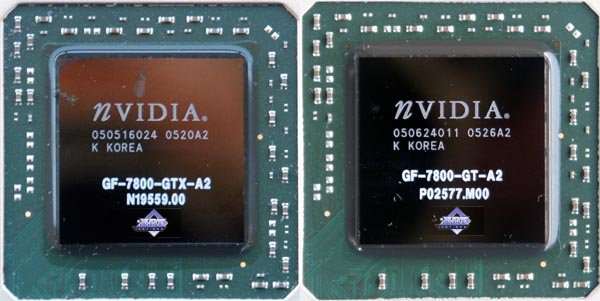 You can see well that the chips look absolutely identical. No bridges or substrate differences can be seen on the GPU. Thus, the four pixel pipelines and one vertex pipeline are locked either inside the die or with the help of programmable registers, or in BIOS. The last two options provide a chance to unlock them. In case of the first option you may kiss goodbye the chance to update GT into GTX. To the pity of overclockers, NVIDIA designers used the first option. But it will be described below. In conclusion of the examination we should note that the card is equipped with a VIVO codec (VideoIn,VideoOut). That is this product may be used by amateurs to capture analog video and record it in digital form. I'd like our constant author, Alexei Samsonov, to make a promise that he would find time to study this codec and write about its features in a separate article.
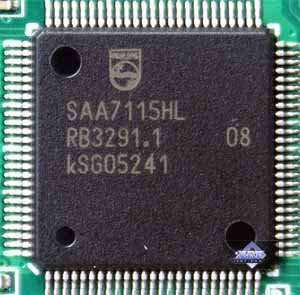
Bundle
Box.
Installation and DriversTestbed configurations:
 We monitored card's temperature during operation, there were expectedly no surges. The core stayed below 80°. Overclocking. ROP/Shader units can operate only at 432, 459, 486, 513 MHz (potentially even higher, but there will hardly be such chips). Only the geometry unit allows to control is operating frequency continuously. This video card does not manage the core frequencies of 486/486/530 MHz because of the first two units, that's why its operation was stable only when overclocked to 459/459/510 MHz. Maximum memory limit is 1120 MHz. Thus we can establish a fact that the 7800GT really uses GTX rejects, chips with even 20 pipelines that can hardly manage 460 MHz in determinant units.
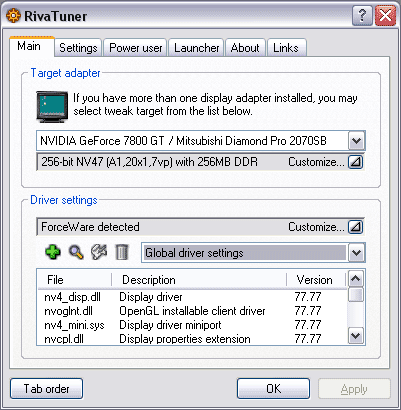
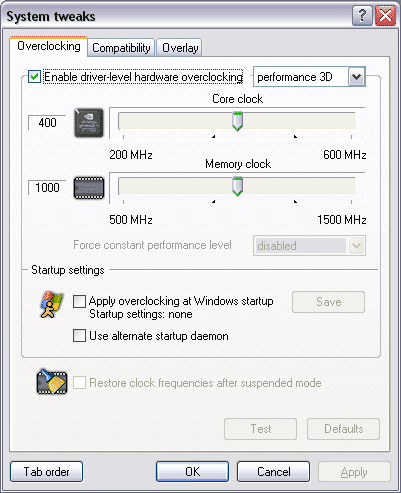 So, here is the GeForce 7800 GT. As you can see, RivaTuner (written by A.Nikolaychuk AKA Unwinder) detects it easily and shows the correct figures on pipelines and frequencies. Monitoring also works fine (you can see it well above). Of course, I tried to unlock 1 quad and 1 vertex pipeline, but this attempt was a failure, as I have already mentioned. Even though this register can be programmed, the number of pipelines is hardcoded in the core. NVIDIA got rid of the problems it had experienced since the NV4x. Information that unlocking 6800/6800LE pipelines was no longer possible appeared at the time of late NV40 (there is a chance that these cards are already equipped with NV48, manufactured by TSMC using the 0.11 micron process technology, where the number of pipelines is hardcoded at the testing stage or even earlier). NV41/NV42 chips for the 6800LE (8 pipelines) cannot be unlocked anymore (12 pipelines). So this is bad time for users who prefer buying cheap video cards and then overclock them to get capacities of more expensive models for free.
Test results: performance comparisonWe used the following test applications:
I have already demonstrated 7800GT emulation in the previous article about the GeForce 7800 GTX from Leadtek (RivaTuner can easily reduce the number of pipelines and decrease frequencies), so it's very interesting to compare these results with those demonstrated by the real 7800 GT.
Let's proceed. I remind you that the direct competitor of the 7800GT in terms of prices is the X850 XT (not PE!). But we have also published the results of the X850 XT PE. Of course, we shall also compare this card with the previous Hi-End flagship from NVIDIA - GeForce 6800 Ultra, which should go down to a cheaper price segment. This product will actually be discontinued as the 7800GT grows cheaper.
Game tests that heavily load pixel shaders 2.0.TR:AoD, Paris5_4 DEMO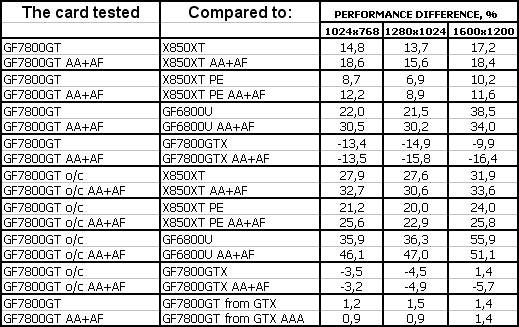 First of all we should say that the 7800GT emulation is practically no different from the real product in terms of performance. What concerns the competition with ATI, it's successful: this card outperforms even the X850 XT PE. Of course, the 7800 GT rates between the 6800 Ultra and the 7800 GTX. Note this important factor: the 7800 GT memory bandwidth is smaller than in the 6800 Ultra! That's why it may be even slower than NV45 in applications where performance depends much on the memory bandwidth (but such games are getting the thing of the past, there appear more games that load shader units). This game depends completely on the performance of such units, so we can see that the 7800 GT heavily outperforms the 6800 U, despite the lower memory bandwidth.
Game tests that heavily load vertex shaders, mixed pixel shaders 1.1 and 2.0, active multitexturing.FarCry, Research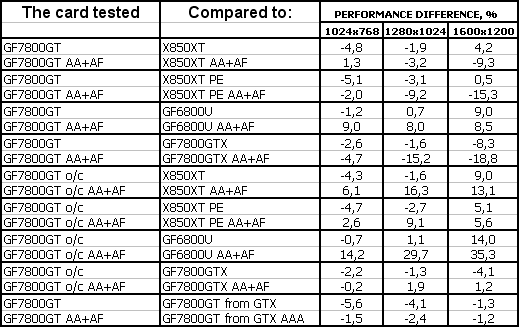 FarCry, Regulator
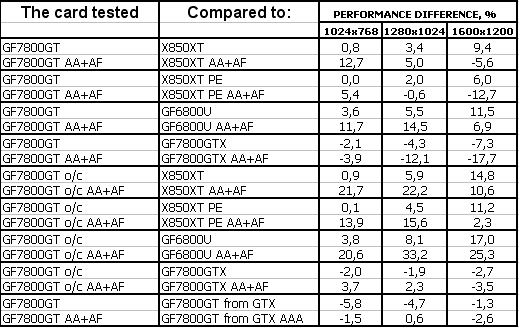 FarCry, Pier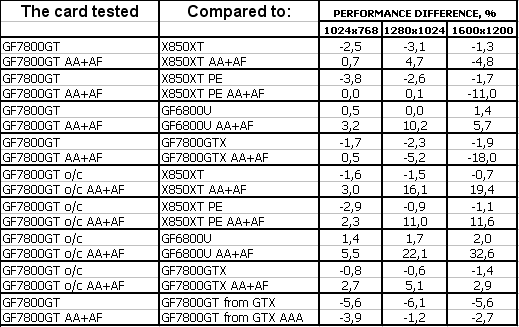 We can see that the 7800GT emulation was also a success, performance difference between the emulation and the real 7800GT does not exceed 5%. What concerns other comparisons, firstly, modes without AA+AF shouldn't be taken into consideration at all, as the bottleneck is a CPU; secondly, even AA+AF cannot load cards so heavily. Unfortunately AA modes higher than 4x differ much between ATI and NVIDIA. Besides, having analyzed Far Cry performance for this year, we gathered that this game had long become the hobby-horse of the Canadian company, who finetuned its drivers for this game. ATI products have been better than equally-priced NVIDIA cards in this test for a long time. So it's not surprising that the 7800 GT is outperformed by the X850 XT PE and is approximately on a par with the X850 XT. That's OK. Besides, the price segment still speaks in favor of the 7800 GT (let's not forget about the HDR potential, which is supported by NVIDIA cards in this game). F.E.A.R. (MP beta)
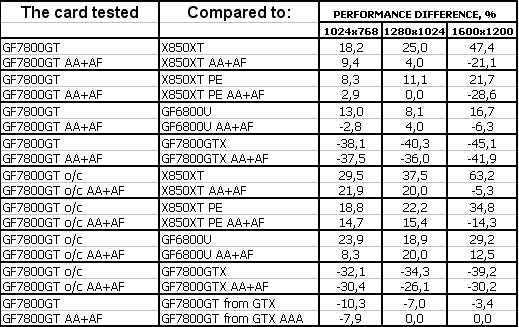 The difference between the emulation and the real 7800GT has reached 10%. What are the reasons? - It's hard to say. I guess the reasons have to do with the drivers. Maybe it's again up to the game that detects cards and adjusts itself to them (the demo version may already "know" the 7800 GTX and still be ignorant of the 7800 GT). But the difference is not that large anyway. But it's already obvious that the memory bandwidth played Old Harry with the 7800 GT in this test. Look how good the 7800 GT is in low resolutions! And how it climbs down at 1600x1200... However, F.E.A.R. provides decent gameplay only at 1024x768 at maximum quality, given you have one of the most powerful accelerators. So the defeat at 1600x1200 is purely nominal.
Splinter Cell Chaos Theory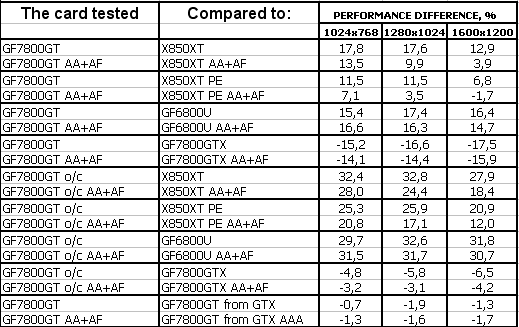 It's a new test that has been introduced to our test method for the first time. This game also heavily loads accelerators that use Shaders 3.0. Unfortunately, even though Version 1.04 includes Shaders 2.0 for ATI cards, this model works only with them. That is NVIDIA cards can work only with Shader Models 1.1 and 3.0. That's why we were forced to compare products working with different models, but with disabled HDR (which is not compatible with AA either). The situation resembles the previous case, the 7800 GT is obviously limited by the memory bandwidth at high resolutions. But on the whole the situation is more favorable to the new product than in the situation above: even the X850XT PE is practically left behind (except for 1600x1200 with AA+AF).
Game tests that heavily load both vertex shaders and pixel shaders 2.0Half-Life2: ixbt01 demo
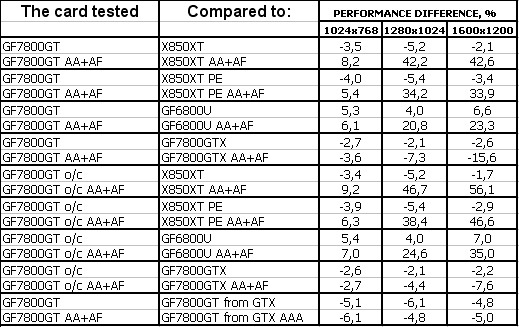 Half-Life2: ixbt02 demo
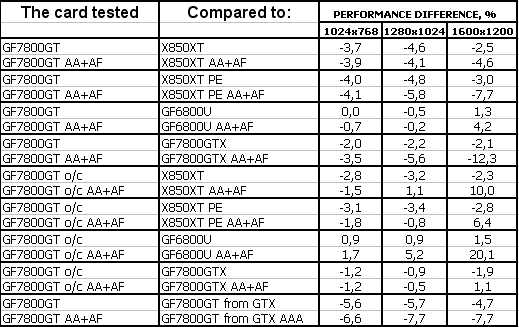 Half-Life2: ixbt03 demo
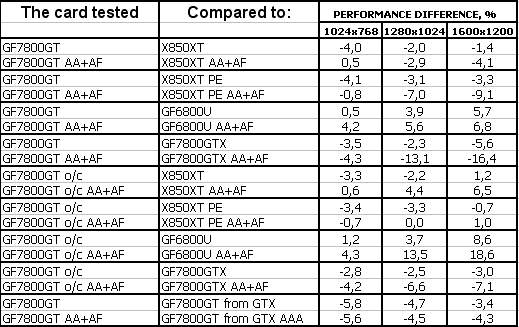 This game is heavily limited by a CPU. Its load on accelerators is rather low, so even the AA4x+AF16x mode cannot load the accelerators "to the brim". Hence the contradictions from test to test (from scene to scene). The general situation for the 7800 GT is not bad, in some places with AA+AF it outperforms the X850XT PE by 20% and higher. Of course, sometimes it's defeated. But on the whole, these defeats don't spoil the impression of the new product. We are to think what to do with HL2 as a test... Regrettably, we may have to exclude it (you can count games with benchmarks on the fingers of one hand!)
Game tests that heavily load pixel pipelines with texturing, active operations of the stencil buffer and shader unitsDOOM III High mode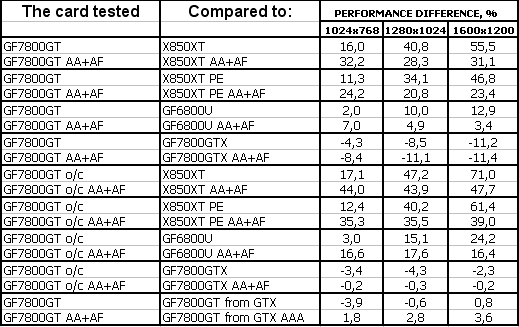 Chronicles of Riddick, demo 44
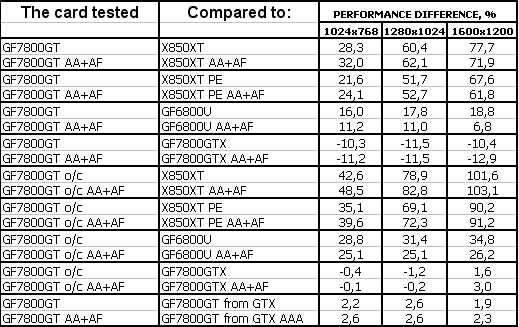 Chronicles of Riddick, demo ducche
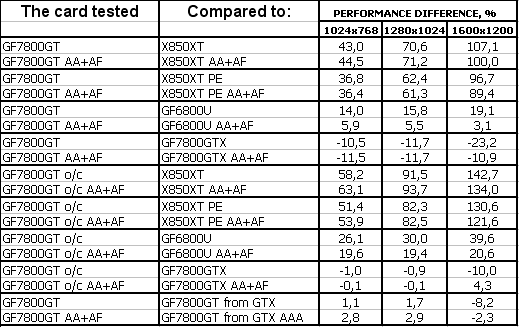 I guess there is no need to comment on the block of tests, where NVIDIA accelerators rule supreme due to a more flexible and longer render pipeline, streamlined and fast stencil-buffer operations, and the fine-tuned OpenGL driver.
Synthetic tests that heavily load shader units3DMark05: MARKS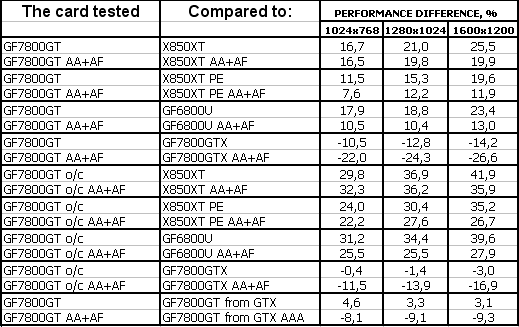 The results are similar to those in TR;AoD, where everything is up to the capacity of shader units.
ConclusionsPalit GeForce 7800 GT 256MB is a very interesting product. The card demonstrated excellent performance results, having outscored even the more expensive RADEON X850 XT PE, to say nothing of the GeForce 6800 Ultra and X850 XT. I guess there is no need in extra dithyrambs, our readers have seen that this card is well worth its price anyway; besides, the price drop is over the horizon. A fly in the ointment for overclockers is that you cannot unblock pipelines, but this card is economically sound anyway, it's even 150% justified if you overclock it. Note the compact dimensions and a quiet cooler. 2D quality in this sample is also excellent: 1600x1200@100Hz - sharpness is up to the mark (in tandem with the monitor specified in the testbed configuration). So, if the prices are not artificially raised and the products appear at least at the prices of X850XT PE, their success will be obvious. I REPEAT that initial prices are always higher than those recommended by the manufacturer. So if these cards are available in August retail at $500, it's quite OK. The 7800 GTX price is still too high compared to the recommended level. And don't forget about Shader 3.0 support, which is not offered by ATI cards. This factor is currently getting increasingly active. We can congratulate NVIDIA with another successful card, which should be wanted on the market. We look forward to price drops for previous products, which should become even more attractive in their price segments.
You can find more detailed comparisons of various video cards in our 3Digest.
NVIDIA GeForce 7800 GT 256MB gets the Original Design award (August). A chip manufacturer gets this award for the first time! It's awarded for the compact design with a quiet cooler for such a high-performance accelerator.

Theoretical materials and reviews of video cards, which concern functional properties of the GPU ATI RADEON X800 (R420)/X850 (R480)/X700 (RV410) and NVIDIA GeForce 6800 (NV40/45)/6600 (NV43)
Write a comment below. No registration needed!
|
| |||||||||||||||||||||||||||||||||||||||||||||||||||||||||||||||||||||
Platform · Video · Multimedia · Mobile · Other || About us & Privacy policy · Twitter · Facebook
Copyright © Byrds Research & Publishing, Ltd., 1997–2011. All rights reserved.